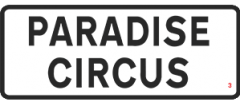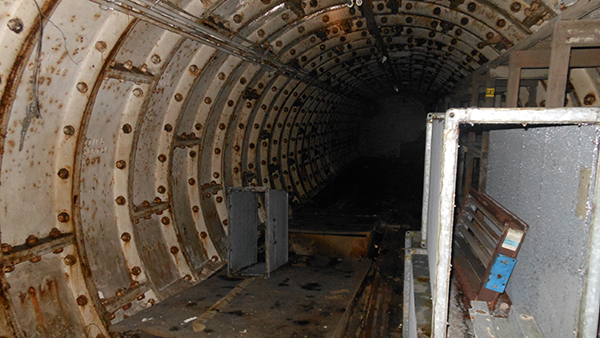The Subterraneans guided tour was developed for the 2013 Flatpack Film Festival. Exploring the Metropolis was a sub-theme of the festival that month and David Bowie had just released his album The Next Day after a decade of silence. From him I borrowed a song title to set the scene for my journey beneath the city.
It was to be my personal ‘Bowie’ moment, with tickets for the event selling out the same day. The festival office reported that every other phone call was a request to go onto the returns list for the event. The landlord of one of the tunnels we visited decreed that only 17 people, plus cameraman, volunteer and myself would be able to have access, once photo ID had been provided. ‘Inaccessible’ had translated into ‘exclusive’. Why such demand to visit dark, dripping, uninviting places? This is one attraction the city provides in freely and in abundance. The answer partly lies in the event being presented as a guided tour: someone else tests the ground, tracks down the key holder, completes the risk assessments and shoulders the responsibility. Exploring alone is lonely, dangerous and marks you as an outsider. Group solidarity defers the anxiety of becoming a marginalised troglodyte.
There were many spaces I couldn’t include in the tour, either because they were too remote or too dangerous to enter. Some locations simply didn’t exist. By the end of the research period, there were more leads to secret tunnels than I could follow up. Some tunnels literally led nowhere. A bar worker I met by chance told me about a secret tunnel connecting the cellar of her pub to …the Town Hall? She knew not exactly where to but was certain that it extended for miles (the pub in question was less than a quarter of a mile from the Town Hall). The reality was established a day later when I shone a powerful torch down the maw of the chest-high aperture in her basement. There, beyond some stacked Lager of Lamot ashtrays lay the back wall, some ten feet distant. The draught she had felt came not from some underworld kingdom but from a pavement-level vent outside. Other landlords would have similar misconceptions of the property they owned: at one point we ventured into a service tunnel beneath Priory Square, past a Narnia-esque wall of stored christmas trees, only to be foxed by a steel shutter after 100 yards. Beyond this, the security team assured us, lay an extensive labyrinth of abandoned passageways allowing delivery by lorry to various shops around the city centre. They could not open it and had never actually been in but advised I should apply to the Square Peg (formerly Lewis’s department store) for access. I told them of another local tunnel I’d heard about: an underground route to transfer ‘the accused’ from the holding cells at Steelhouse Lane Police Station directly to the dock. Interestingly they dismissed it as a legend.
Finding out who owned whatever was behind that shutter and how to get it open took up most of the next month. Thorough ID checks were required as the service tunnel was accessed via underground car-parking space used by the judiciary. Final approval was a result of a fluke: the landlord imagined that because the Film Festival was asking for access, a feature film was going to be made there. We hinted that David Bowie was planning a sequel to Labyrinth and within weeks were standing with the key holder several meters beneath Old Square. A heavy iron door creaked open to reveal a metal shutter: it proved to be the same one where we’d seen the christmas trees. Those miles of tunnel were a myth: the security staff’s fears and hopes of what was behind there. Eye opening to see how legends are created! Despite busting the myth, a bonus tunnel emerged during this field trip: behind a doorway now neatly labelled Store Room 2, a preserved length of railway tunnel that once connected New Street Station and Moor Street Station.
The Steelhouse Lane tunnel proved to be real, if shorter than expected. I have discovered that citing ‘historian’ as my profession has opened more doors than holding official ID, calling myself ‘curious bystander’ or even having the actual keys ever has, and it was quick business to find ourselves in this white tiled passageway a few days later. The holding cells are still in use (though not for much longer) and have a distinctly Victorian atmosphere. The unoccupied cells were sparse and we were warned we would have to leave if the prisoners need to be transported. The tunnel to the court rooms is lined with white glazed bricks, a century’s continuous use now evident on their surface. Black electric cables snake across the tiles, not quite fitting into the original design.
The holy grail of Birmingham Tunnels is the Anchor Exchange: a cold war construction under the city to facilitate telecommunications after the bomb dropped, which at the time seemed inevitable. As industry declined, the water table rose and the rumour was that the tunnels, now dangerously deteriorated, were constantly being pumped out to avoid flooding. I met with a former BT engineer who worked there as a teen in 1982. He explained he’d signed the official secrets act and wouldn’t be able to tell me much but three pints of Peroni into the evening, the full story emerged. Access was (and is) via a lift shaft off Newhall Street. His first impression was of how vast the tunnels were – not pokey darkened warrens but generous, illuminated thoroughfares. BT staff would use them as direct shortcuts through the city but the purpose was in 1982 day-to-day telecommunications rather than post-catastrophe panic rooms. The secrecy involved had more to do with security risks associated with opening up handy access and getaway tunnels beneath the city, especially with IRA activity at its zenith. The current understanding of the tunnels seems to suggest inaccessibility and decrepitude. However, clues on the surface suggest new activity down there. The Subterraneans tour visited a sequence of above-ground shafts that access and ventilate the tunnels. A BT-owned courtyard is now openly named Anchor Yard. A sign attached to the railings reads: ‘Project Fox operatives: report to 07778 ______’ and I of course called the number: “I’m at the gate, what do I do now?” but no information was forthcoming. A bit of poking around revealed Fox to be ‘FOCS’ – Fibre Optic Cables [Something]’. The new use for the tunnels is as a duct for broadband. You can infiltrate the tunnels by training as a BT Openworld engineer.
Other places I visited during the research phase included church vaults stacked high with skulls, the underground courses of forgotten rivers such as the Hockley Brook and even banal locations such as filled in subways, with disenfranchised handrails projecting at shin height. Each had their own reason for being banished to the underworld and warranting inclusion on the tour. A sequel is already in preparation… I remain fascinated how many people have their own tunnel lore to share when the subject is raised.

